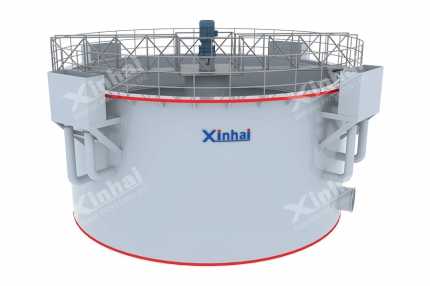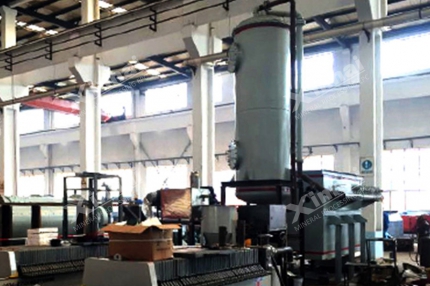At present, according to the complexity of the ore composition and the difficulty of beneficiation, gold ores can be roughly divided into poor sulfide ores, high sulfide gold ores, polymetallic sulfide gold-bearing ores, gold-bearing copper ores, and telluride-bearing gold ores. and gold-bearing oxide ores. Different types of gold ore have different beneficiation processes due to their different properties. Next, let's take a look at the ore characteristics of various types of gold ores and their commonly used beneficiation process.

Use the table of contents below to navigate through the guide:
01Sulfide-lean gold ore and its beneficiation process
The composition of these minerals is relatively simple, and most of them are of quartz vein type or hydrothermal alteration type. Pyrite is the main sulfide, but the content is small, sometimes accompanied by minerals such as copper, lead, zinc, tungsten, and aluminum. Gold minerals are mainly natural gold, other minerals have no recycling value or can only be recycled as by-products.
Sulfide-poor ores can be sorted by simpler gold beneficiation processes. For example, coarse-grained gold is recovered by gravity separation process, fine-grained gold is generally recovered by flotation process, flotation concentrate is treated by cyanidation process, and very fine-grained lean ore is recovered by full-slime cyanidation process.

02High sulfide gold ore and its beneficiation process
This type of ore contains a lot of pyrite and arsenopyrite, and is the same as gold as the recycling object. The gold grade is low, and the natural gold particles are relatively small, and are mostly wrapped in pyrite and arsenopyrite.
Usually, gold and sulfide are separated out by flotation, and then the gold concentrate is cyanided to obtain gold products and cyanide tailings containing a large amount of pyrite and arsenopyrite, respectively. The separation process is used to separate pyrite and arsenopyrite.
03Polymetallic sulfide gold ore and its beneficiation process
This type of ore is characterized by high sulfide content. In addition to gold, the ore also contains copper, lead, zinc, silver, tungsten, antimony and other metal minerals, and the latter often has the value of separate mining and recovery. Gold particle size varies widely, and its distribution in ore is particularly uneven. In addition to being closely related to pyrite, natural gold is also closely symbiotic with minerals such as copper, lead, zinc, silver, tungsten, and antimony. Metal minerals that need comprehensive recovery diverse.

For the separation of this type of gold-bearing ores, it is necessary to first determine the type of ore, and then determine the specific beneficiation process according to the difference between its metal minerals and gangue minerals. For example, for the gold-bearing copper-iron ore, the main metal minerals are chalcopyrite and magnetite, while the natural gold occurs in the chalcopyrite in the form of fine particles, which can be carried out by the combined flotation-magnetic separation process. After sorting, two kinds of products, such as gold-bearing copper concentrate and iron concentrate, are obtained respectively.
04Gold-bearing copper ore and its beneficiation process
The difference between this type of ores and the gold-bearing copper sulfide ore in polymetallic sulfide gold-bearing ores is that the grade of gold is lower, but gold is the main comprehensive recovery element. The particle size of gold minerals is medium, and the symbiotic relationship with copper minerals is complex. Flotation + flotation concentrate pyrolysis can be used for separation, that is, the copper-gold concentrate is obtained by flotation first, and then the copper-gold concentrate obtained by flotation is separated. Mine is sent to a smelter for smelting, and gold is recovered during the smelting process.

05Telluride-containing gold ore and its beneficiation process
Gold-bearing minerals are still dominated by natural gold, but a considerable part of gold occurs in gold sulfides. These ores are mostly low-temperature hydrothermal deposits in terms of origin, and the gangue minerals mainly include quartz, chalcedony quartz and carbonate minerals. Such gold-bearing ores are often recovered by flotation. Due to the brittleness of gold telluride minerals, it is easy to sludge during the grinding process, which brings difficulties to the flotation of gold telluride minerals. Therefore, when processing gold telluride ores, stage grinding and stage flotation are often used.
06Gold-bearing oxide ore and its beneficiation process
The main metal mineral is limonite, which contains no or less sulfide, but contains stable secondary minerals such as gold-containing iron hydroxide or iron hydrous oxide and part of quartz, which are the main characteristics of this type of ore mineral composition. . Most of the gold occurs in the main gangue minerals and weathered metal oxide fissures. The gold particle size varies greatly, and the mineral composition is relatively simple. The separation processes are mainly gravity separation and cyanidation.

For some oxidized ores, gravity separation+cyanidation process is often used for separation. For all oxidized ores, coarse-grained gold is recovered by gravity separation, ore slime is cyanided by stirring, and ore sand is sorted by percolation cyanidation.
Gold ore resources are very precious. In order to select ores more reasonably, the gold ore beneficiation process is very important. If you want to select gold from gold ore in a more economical and environmentally friendly way, you should first conduct a beneficiation test, analyze the properties of the ore, and obtain a scientific beneficiation test report, so as to judge which gold beneficiation process to use, and comprehensively consider the gold ore. The beneficiation plan is determined after the actual situation of the beneficiation plant, investment and other factors to achieve an ideal return on investment.


 marketing@ytxinhai.com
marketing@ytxinhai.com  0086 13810327080
0086 13810327080 






































































































 CHAT
CHAT MESSAGE
MESSAGE







